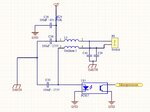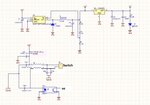erenkcms
Junior Member level 3
Hi everybody,
I have a problem about photocoupler. I have attached my schematic.when the P9 switch on/off, i take this changing by U15(PC817) to my microprocessor, but my problem is when P9 switch on/off more than 1 times, the U15(PC817) break down..?? when i change U15 , it works a little bit time and again break down U15..WHY? Do you have ANY idea??Please help me...!!!!
I have a problem about photocoupler. I have attached my schematic.when the P9 switch on/off, i take this changing by U15(PC817) to my microprocessor, but my problem is when P9 switch on/off more than 1 times, the U15(PC817) break down..?? when i change U15 , it works a little bit time and again break down U15..WHY? Do you have ANY idea??Please help me...!!!!
Attachments
Last edited:

